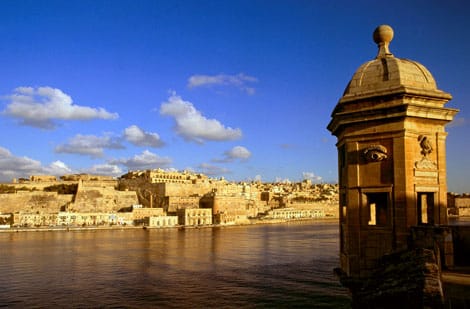 Remarkably rich with history and rugged physical beauty, the small island of Malta is truly considered one of the Mediterranean’s gems. With a past dating back to the Neolithic age and a location at the crossroads of the world, Malta, despite its size – has factored importantly into the tale of the ages, both in Europe and beyond. Having such a central location within the sea has given the island many cultural influences, both European and Arabian. However, over the centuries a distinct and charming Maltese culture has certainly emerged, and there is no better way to absorb this culture than by traveling to the Malta’s capital city, Valletta. Located on a picturesque harbor on the island’s eastern coast, Valletta, though small, is absolutely packed with some of the finest cuisine, sightseeing, and cultural opportunities in all of Europe. With a population of only 6,966, Valletta is amongst the smallest of Europe’s capitals. What the city lacks in size, however, it more than makes up in history.
Remarkably rich with history and rugged physical beauty, the small island of Malta is truly considered one of the Mediterranean’s gems. With a past dating back to the Neolithic age and a location at the crossroads of the world, Malta, despite its size – has factored importantly into the tale of the ages, both in Europe and beyond. Having such a central location within the sea has given the island many cultural influences, both European and Arabian. However, over the centuries a distinct and charming Maltese culture has certainly emerged, and there is no better way to absorb this culture than by traveling to the Malta’s capital city, Valletta. Located on a picturesque harbor on the island’s eastern coast, Valletta, though small, is absolutely packed with some of the finest cuisine, sightseeing, and cultural opportunities in all of Europe. With a population of only 6,966, Valletta is amongst the smallest of Europe’s capitals. What the city lacks in size, however, it more than makes up in history.
Malta dates back to antiquity, with the first evidence of human inhabitation as early as 5000 B.C. For the next several millennia, control of the island was tossed around between the Phoenicians, the Greeks, the Romans, and subsequently the Byzantines. The golden age of the island of Malta and indeed Valletta itself came about in the Middle Ages, when, in 1127, Malta was captured by the Sicilian King Roger II, who established Christianity as the island’s religion. From that point onward, Malta became a vital base of operations for the Catholic Church in the Southern Mediterranean, and especially for crusaders on their way to Jerusalem. Indeed, the Knights Hospitaller, one of the most fearsome and universally respected orders of crusaders, were better known simply as the “Knights of Malta.” Malta remained under Italian control until 1934, when they became an official part of the British Empire. Finally, in 1964, the island became an independent nation, which it remains to this day.
If sightseeing is what you’re after, opportunities abound on this small island. In addition to the city of Valletta itself being an UNESCO World Heritage Site, there are two ancient monuments in the surrounding area that have also been designated with this honor. The Hypogeum of Hal-Saflieni is a vast underground building that dates back to 2500 B.C., and is truly an ancient wonder. Simply referred to as “the labyrinth” by the Maltese, the Hypogeum is now recognized as the world’s only prehistoric underground temple. However, due to the fragile and delicate nature of the structure, there is a strict limit of eighty visitors per day, so arrive early! If more ancient monuments are what you’re looking for, a mere five minute walk from the Hypogeum will take you to the Tarxien Temples, the largest collection of ancient buildings on the island. Three large temples make up the site, the oldest of which is thought to be over five-thousand years old. The Tarxien and Hypogeum complexes are located only several miles outside of the city center of Valletta, and easily reached by a number of different buses that run throughout the day.
If Medieval and Renaissance history is more your thing, Valletta offers an abundance of sightseeing options. St. John’s Co-Cathedral is the largest church on the island, and though it may not appear like much from the outside, the interior is considered one of the grandest sanctuaries in the whole of Europe. Located next door, the Cathedral Museum contains art from some of the greatest Italian painters of the Renaissance, including two works by Caravaggio. In addition, the coastline surrounding Valletta contains several forts dating to the 16th century, amongst them Fort. St. Elmo, and the remnants of the city walls that go back to medieval times. Remember, though, that the entirety of Valletta’s city center is itself an UNESCO World Heritage Site, so no matter where you go you will be stumbling across some of the finest cultural treasures in the world. Walking through the nearly-unchanged city, one truly gets the feeling of being connected personally to a long-bygone age.
After a long day of sightseeing, make sure some energy is saved for the boundless dining and entertainment options in Valletta, which has been famous across the centuries for some of the finest seafood in the Mediterranean. To truly act like belti (a person from Valletta), be sure to wash down your meal with a pint of Cisk, the local sweet lager. Having such a rich and multicultural history truly makes Malta one of the most unique destinations in Europe. Another pleasant surprise for the visitor to Valletta will be the cost; despite being on the Euro, Valletta is one of the most affordable destinations in the Mediterranean. In addition, an added benefit of Malta’s period of British rule is that nearly every citizen speaks English fluently, as it holds official language status with Maltese. From the ancient monuments to the Medieval cathedrals and fortresses, the laid-back local culture to the astounding physical beauty of the area, travel to Valletta will certainly not disappoint even the most discerning of travelers
